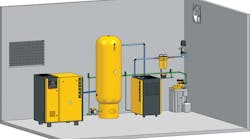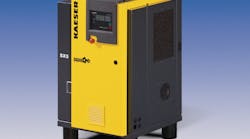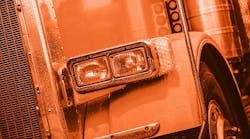As with electricity and other utilities, compressed air is usually taken for granted. It's often when there's a problem and not much can get done in the shop without it that shop owners realize the importance of a good, reliable compressed air system.
Further, interruptions with compressed air in a fleet maintenance shop can be significant, as the financial impact of not having vehicles on the road will be much greater than the cost to repair the air system itself.
The reliability of the system goes beyond the quality of the compressor you buy. It's about how the system is designed and maintained.
The good news is it isn't rocket science. If you build and operate your system to avoid common problems - including inadequate flow, leaks and pressure drop - you'll save time and money in keeping your business going.
FLOW
- Operating at the correct pressure. First, don't confuse pressure and flow when sizing a compressor. What determines the amount of air you get at your tools is flow, which is expressed in CFM (cubic feet per minute).
Flow is determined by the size and efficiency of the compressor pump and the motor driving it. It's common to refer to compressors by horsepower, but compressed air system professionals prefer to size compressors by cubic feet per minute (CFM).
A rule of thumb is that piston compressors produce 3 to 4 CFM per horsepower and rotary compressors produce 4 to 5 CFM per hp.
Any compressor can be configured to operate at a range of pressures. Whether it's a 5 hp or a 25 hp unit, the typical two-stage piston found in automotive service facilities can run up to 175 pounds per square inch gauge (psig). But you won't get much more than 15 CFM from the 5 hp one. Similarly, 5 hp rotary screw compressors are available from 80 to over 200 psig, but you won't get much more than 20 CFM from it.
It's important to know that the higher the pressure, the less flow you will get from a compressor.
Many shops operate their compressors at 145 or 175 psig. But in fact, very few tools require pressures above 100 psig.
Avoid a common pitfall, select the correct pressure. Don't over-pressurize. The higher the system pressure, the greater the volume lost through leaks and the higher the energy consumption.
- Determining demand. When sizing your air compressor and receiver tank, add together the flow required by the largest air consumer at each work station, then multiply the total by the percentage of time each tool is used. This requires some study of how the different parts of the repair shop operate throughout the day.
DUTY CYCLE AND TANK CONSIDERATIONS
- Duty cycle considerations. When selecting compressors, you must consider the CFM delivered and the recommended duty cycle. Duty cycle is the percentage of time a compressor can operate without the risk of overheating and causing excessive wear to the compressor.
A piston compressor may provide adequate flow for a short period, but most commercial piston compressors are limited to 60 to 70 percent duty cycle. For this reason, piston compressors are usually oversized to allow the compressor to periodically shut down and cool off because of the high operating temperatures (300 to 400 degrees F).
Rotary compressors, on the other hand, have fluid cooling circuits that allow 100 percent duty cycle (i.e., 24/7 operation) if needed.
- Tank considerations. Tanks do two important things. 1. They store up air so that the compressor can shut off. This saves energy in all compressors, but is also critical for the long-term health of piston compressors because it allows them to cool down. 2. The tank is used to remove water and other contaminants from the air stream.
Tanks require very little attention or service, but water can accumulate very quickly (especially in warmer months), eliminating space for air storage.
The compressor draws in ambient air from its environment, which by nature contains water. For example: On a 75 degrees F day with 75 percent relative humidity, a 10 hp compressor can introduce up to 7.5 gallons of water into a compressed air system. At 90 degrees F with 90 percent relative humidity, that same compressor will introduce 15 gallons of water in the compressed air system per day.
A reliable automatic drain will remove that liquid so the tank stores air, not water.LEAKS
- Find and fix leaks. Leaks are very, very common. Numerous compressed air industry studies confirm that as much as 35 percent of all compressed air produced is lost through leaks.
Leaks waste energy and steal air from tools that need it. A 1/16-inch leak loses 7 to 8 CFM at 120 psig. At 150 psig, it loses 9 to 10 CFM. That's half the air from a 5 hp compressor.
Hoses, pipe joints, valves and fittings are hot spots for leaks. If you can hear or feel a leak, the savings from fixing it will pay back the repair cost almost immediately.
There are other techniques for finding the leaks you cannot easily hear or feel, but start with the obvious ones. (For a free white paper on leak detection go to www.kaeser.com/whitepapers.)
PRESSURE DROP AND PIPING
Restrictions in airflow create air turbulence/friction that reduce system pressure. The major causes are: piping that is too small in diameter, rough pipe interior, too many bends and turns in the distribution system, changes in system diameter and un-serviced filters.
There will always be some pressure drop, but it can be greatly reduced with proper system design and maintenance.
- Correct the true causes of the pressure drop. Do not try to overcome pressure drop with more horsepower. Trying to stuff more air flow won't overcome the pressure drop. It will just use more electricity.
Be sure to account for the total pressure drop when selecting the compressor's operating pressure. An important rule of thumb is that every 2 psi increase in pressure increases energy consumption 1 percent. Therefore, increasing system pressure to overcome pressure drop will consume more energy, increase the amount of air lost through leaks and shorten motor life.
- Consider a larger pipe diameter. Pressure drop changes exponentially with pipe diameter. Bigger is better. Bumping up just one pipe size makes a big difference in pressure drop.
For example: The pressure drop of 40 CFM from a 10 hp compressor through 500 feet of straight 3/4-inch smooth pipe would be about 8 psi. If added another 10 hp compressor was added, the total flow would be about 80 CFM and the pressure drop would increase to 32 psi.
An increase to 1-inch diameter pipe would change these numbers to 2 psi and 9 psi, respectively.
The longer the pipe run, the more the pressure drop, but pressure drop increases only proportionally with length.
- Other piping recommendations. Compressed air piping material and condition impact performance, pressure drop, energy costs and air quality. Here are some tips for system design:
- Plan for future growth and install the largest pipe diameter feasible.
- Minimize the use of pipe "T"s and right angles.
- Install a flexible hose between the compressor or tank and the piping to eliminate stress on pipe connections caused by compressor vibration.
- Provide adequate bracing/support when hanging pipe from ceilings or walls.
- Use only full flow ball valves to minimize pressure drop.
- Loop distribution to balance pressure and flows at all points of use.
- Connect point of use pipe drops to the top of the header to reduce moisture carry-over.
- Install drip legs at each point of use to capture residual moisture.
AIR QUALITY
Compressed air quality is a common issue, especially in summertime and year round in humid climates. You know you have a problem if oily water is coming out the end of airlines into your tools, tires and spray finishes.
Contaminants increase tool wear and reduce product quality, so it pays to get them out.
- Moisture is present in the air. Every 20 degrees F increase approximately doubles the air's ability to hold moisture. The higher the operating temperature of the compressor, the harder it is to get the moisture to cool and condense out.
Refrigerated dryers are economical and effective in cooling moisture vapor so it can be removed. But dryers are only part of the solution. Almost all the other system components play important roles in moisture and contaminant removal before the air gets to the dryer.
- Different environments, different air treatment needs. What you use the air for determines the level of air quality needed, and the environment directly impacts the type and degree of air treatment needed to reach that air quality. Here are some basic recommendations to achieve clean, dry air in different environments:
- Moderate climate: Compressor, tank, refrigerated dryer (with built-in filtered separator) and a coalescing filter (if needed).
- Hot, humid climate: Compressor, liquid separator, tank, refrigerated dryer (may need to be slightly oversized) and a coalescing filter (if needed).
- Hot dusty environment: Compressor, liquid separator, tank, refrigerated dryer (may need to be slightly oversized), coalescing filter (if needed) and particulate filter.
- Cold environments: If you have any hoses or lines going outside where it is cold (below 40 degrees F), you may benefit from putting a membrane or desiccant dryer on that line before it goes outside. This will further reduce moisture that might freeze up tools.
These dryers consume compressed air so you only want to use them for lines that get cold. If your main airline goes outside before branching to the users, you should consider a desiccant dryer sized for the whole system.
- Compressor selection. Compressor selection impacts air quality. Rotary compressors operate much cooler than piston units, plus they have more effective after-coolers. They condense a lot of moisture into liquid as it's leaving the compressor for easy removal.
Another consideration is compressor oil/fluid. The piston design allows much more oil to pass from the compressor. Rotary units have separation systems that clean and recirculate nearly all of their compressor fluid.
- Liquid separators. Liquid separators remove moisture that has already condensed to liquid. These simple and inexpensive devices provide great first-stage moisture separation after the cooler on a rotary compressor.
With piston units, however, it is sometimes better to go into the air receiver tank before the separator.
Air tanks usually provide a bit of cooling that condenses some more moisture vapor to liquid before the air heads into the dryer. Most refrigerated dryers have liquid separators built-in.
- Particulate filters. Systems in high dust areas will benefit from particulate filters. Coalescing oil removal filters are recommended if there is a lot of oil carry-over, and they are essential if the air is used for spraying paint or sensitive equipment.
- Drains. Coolers, tanks, dryers and filters will separate contaminants from the air, but to actually remove them from the air system, they need drains. Spend the extra money for a high-quality automatic drain for liquid separators, receiver tanks and coalescing filters. Any decent refrigerated dryer has one built in.
COMPRESSOR LOCATION
- Site considerations. Compressors are often installed where their noise, vibration and heat will least bother staff and customers, rather than where they'll best perform and be easily serviced. Compressors need good, clean inlet air and ventilation to maintain proper operating temperature and long operating time, but they are commonly found in dark, dirty and hot rooms. This is not a recipe for success. Provide good lighting and good access for maintenance.
- Compressor considerations. Though more expensive, rotary compressors run much cooler and quieter, presenting more flexibility in where you put them. Many air users opt for less expensive piston machines and then build special rooms for the compressors to isolate them. Before going this route, consider the cost of construction and lost floor space.
FINAL THOUGHTS
Consider all the facts when setting up a new shop or retrofitting an existing facility. Look at capacity and the potential for growth, and make your selections based on an honest evaluation of available technology.
There are formally trained compressed air professionals who can advise you on the right system for your applications and your day-to-day needs. We recommend you consult them, just as you would an HVAC company when putting in central heating and air conditioning.
After investing in the right equipment, make sure you have a preventive maintenance plan in place. Routinely check for leaks and replace filters as recommended.
A qualified compressed air professional who understands your needs can provide you with information on how to best maintain your compressed air equipment and ensure years of reliable service.





